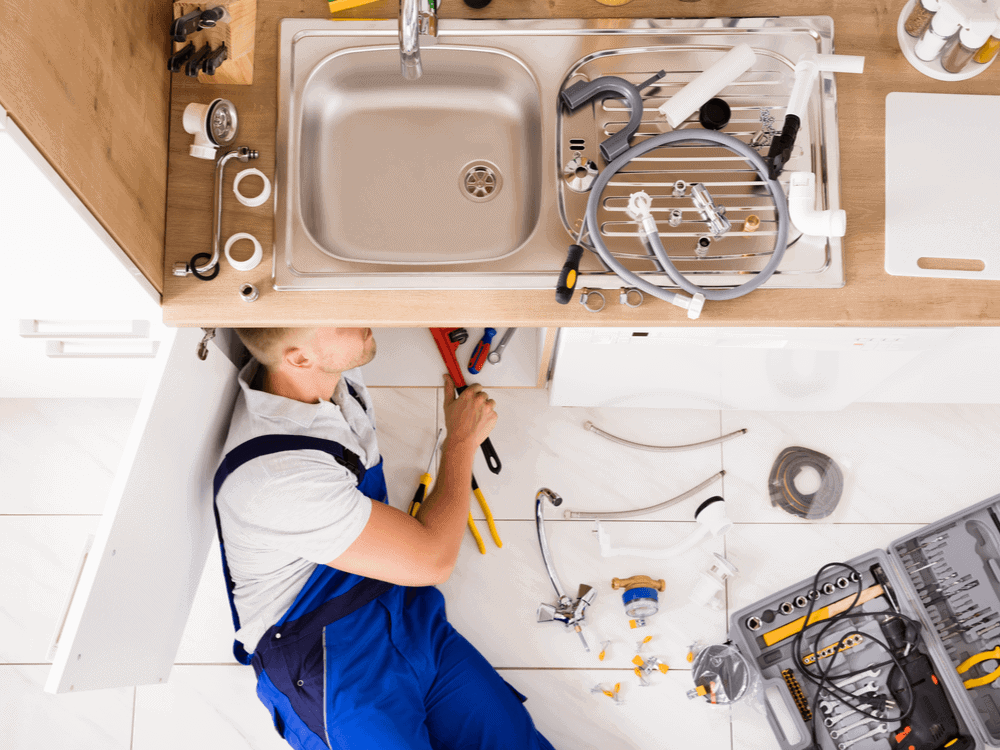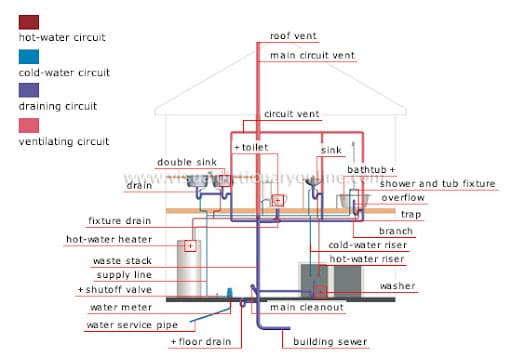A Closer Look at The Layout of Your House's Plumbing System
A Closer Look at The Layout of Your House's Plumbing System
Blog Article
What are your thoughts and feelings on Understanding Your Home's Plumbing Anatomy?

Recognizing exactly how your home's plumbing system works is necessary for each homeowner. From supplying clean water for drinking, food preparation, and showering to securely removing wastewater, a properly maintained plumbing system is crucial for your household's wellness and comfort. In this detailed overview, we'll check out the intricate network that comprises your home's pipes and offer pointers on upkeep, upgrades, and dealing with usual problems.
Intro
Your home's pipes system is more than just a network of pipelines; it's an intricate system that guarantees you have accessibility to tidy water and efficient wastewater removal. Knowing its components and exactly how they interact can help you stop pricey repairs and guarantee whatever runs efficiently.
Basic Parts of a Pipes System
Pipes and Tubing
At the heart of your pipes system are the pipes and tubing that lug water throughout your home. These can be made from numerous materials such as copper, PVC, or PEX, each with its benefits in regards to durability and cost-effectiveness.
Fixtures: Sinks, Toilets, Showers, etc.
Components like sinks, commodes, showers, and bath tubs are where water is used in your home. Understanding exactly how these components attach to the plumbing system helps in identifying issues and preparing upgrades.
Valves and Shut-off Points
Valves control the flow of water in your pipes system. Shut-off shutoffs are essential during emergency situations or when you need to make repair work, allowing you to isolate parts of the system without disrupting water circulation to the entire house.
Water Supply System
Main Water Line
The major water line attaches your home to the municipal water supply or a personal well. It's where water enters your home and is dispersed to numerous fixtures.
Water Meter and Pressure Regulatory Authority
The water meter steps your water usage, while a pressure regulator ensures that water moves at a secure stress throughout your home's plumbing system, avoiding damage to pipelines and components.
Cold Water vs. Hot Water Lines
Comprehending the distinction in between cold water lines, which provide water straight from the major, and hot water lines, which bring heated water from the water heater, aids in fixing and planning for upgrades.
Water drainage System
Drain Piping and Traps
Drain pipelines bring wastewater far from sinks, showers, and bathrooms to the drain or septic tank. Catches protect against drain gases from entering your home and additionally catch debris that could create obstructions.
Air flow Pipelines
Air flow pipes allow air into the water drainage system, avoiding suction that can reduce water drainage and cause catches to vacant. Appropriate ventilation is essential for preserving the integrity of your plumbing system.
Importance of Correct Drainage
Making certain proper water drainage stops back-ups and water damages. Frequently cleaning drains pipes and maintaining catches can avoid pricey repair work and expand the life of your pipes system.
Water Heating System
Kinds Of Hot Water Heater
Water heaters can be tankless or traditional tank-style. Tankless heating units warmth water on demand, while tanks save warmed water for instant use.
Just How Water Heaters Link to the Plumbing System
Recognizing how water heaters link to both the cold water supply and warm water distribution lines assists in detecting issues like inadequate warm water or leaks.
Upkeep Tips for Water Heaters
Routinely purging your hot water heater to remove sediment, examining the temperature level setups, and evaluating for leakages can extend its life expectancy and boost energy performance.
Typical Pipes Problems
Leakages and Their Causes
Leakages can happen because of maturing pipes, loosened fittings, or high water stress. Addressing leaks immediately protects against water damages and mold growth.
Obstructions and Obstructions
Blockages in drains pipes and commodes are usually triggered by flushing non-flushable things or a buildup of grease and hair. Using drainpipe screens and being mindful of what drops your drains can stop obstructions.
Signs of Pipes Troubles to Watch For
Low tide stress, slow drains pipes, foul odors, or abnormally high water costs are signs of prospective plumbing issues that ought to be resolved promptly.
Plumbing Upkeep Tips
Normal Examinations and Checks
Schedule annual plumbing assessments to capture issues early. Look for signs of leaks, rust, or mineral build-up in faucets and showerheads.
DIY Upkeep Tasks
Straightforward jobs like cleansing tap aerators, checking for toilet leaks utilizing color tablet computers, or shielding revealed pipelines in chilly environments can protect against major plumbing problems.
When to Call a Professional Plumbing Technician
Know when a plumbing problem needs expert know-how. Trying intricate repair work without proper expertise can cause more damage and higher repair work prices.
Updating Your Pipes System
Factors for Updating
Updating to water-efficient components or changing old pipelines can boost water top quality, minimize water bills, and increase the worth of your home.
Modern Pipes Technologies and Their Benefits
Check out technologies like smart leak detectors, water-saving toilets, and energy-efficient hot water heater that can save money and reduce ecological influence.
Cost Considerations and ROI
Calculate the upfront prices versus long-term savings when considering pipes upgrades. Lots of upgrades pay for themselves via minimized utility expenses and fewer repairs.
Ecological Impact and Conservation
Water-Saving Components and Devices
Setting up low-flow faucets, showerheads, and commodes can considerably decrease water use without sacrificing efficiency.
Tips for Decreasing Water Use
Basic practices like repairing leaks without delay, taking shorter showers, and running full lots of washing and dishes can conserve water and reduced your energy bills.
Eco-Friendly Pipes Options
Take into consideration sustainable plumbing products like bamboo for floor covering, which is durable and eco-friendly, or recycled glass for counter tops.
Emergency Readiness
Steps to Take Throughout a Plumbing Emergency
Know where your shut-off shutoffs are located and how to switch off the supply of water in case of a ruptured pipe or significant leak.
Importance of Having Emergency Situation Get In Touches With Handy
Maintain contact info for neighborhood plumbing technicians or emergency situation services conveniently offered for quick response during a pipes crisis.
Do It Yourself Emergency Fixes (When Relevant).
Short-term fixes like utilizing duct tape to spot a leaking pipeline or placing a pail under a leaking tap can decrease damages until a specialist plumbing professional arrives.
Verdict.
Recognizing the anatomy of your home's plumbing system encourages you to preserve it properly, saving money and time on repair work. By complying with regular maintenance regimens and staying educated about modern-day plumbing innovations, you can guarantee your plumbing system runs successfully for several years to come.
HOW YOUR PLUMBING SYSTEM WORKS
Which Pipes Do What?
Blue lines = fresh water supply entering the building
Red lines = hot water supply entering the building
Grey lines = pipes carrying waste away from the building and venting pipes carrying gases away from the building (through the roof)
YOUR MAIN PLUMBING SYSTEMS
There are two main plumbing systems that support your home s basic plumbing needs one that brings clean water into your home, and one that sends dirty water away from your home. Connected to the toilet, bath, shower, and other faucets in your home, these two systems keep your water flowing in the right directions.
ACCESSING FRESH WATER
Fresh and clean water is brought into your home through the main water supply line . Filtered through one pipe, this water is pressured to flow into the various fixtures in your home at any given time.
This water can be sourced from a well located on your property, a pond or river (mostly cottages), or, as in most cases, from the city s municipal water treatment centre. However, it is important to note that water that is untreated, such as the water siphoned from ponds or rivers, may not be safe to drink. Personal water supplies always need to be treated for hardness and contaminants before consumed.
MUNICIPAL WATER SUPPLIES
Improve taste and odour
Remove sediment
Eliminate hardness
Reduce chlorine
COLD WATER SUPPLY VS. HOT WATER SUPPLY
Cold water flows into your home or building through the service line, which then distributes hot or cold water to your fixtures. This line is most commonly run through a central column that runs floor to floor. Hot water runs in short and straight pipes as the longer the pipeline, the more heat that will be lost in the transfer. Having shorter pipes also allows residents to access hot water more quickly.
WASTE WATER SYSTEM
Your wastewater system is divided into two parts pipes that send wastewater away from your home and venting pipes that send sewer gas away from your home. Sewage water travels through pipes that flush the water and waste towards local sewers that are operated and managed by your city or town. Most sewer systems rely on gravity to move the wastewater to where it needs to go.
The further away from your toilet or sink, the larger wastewater pipes become. This allows for waste to be disposed of from various parts of your home or business at once without pipe blockages. The angle and flow of these pipes are also essential for keeping your waste pipes clear of build up.
https://harrisplumbing.ca/how-your-home-plumbing-system-works/

HOW YOUR PLUMBING SYSTEM WORKS
Which Pipes Do What?
YOUR MAIN PLUMBING SYSTEMS
There are two main plumbing systems that support your home s basic plumbing needs one that brings clean water into your home, and one that sends dirty water away from your home. Connected to the toilet, bath, shower, and other faucets in your home, these two systems keep your water flowing in the right directions.
ACCESSING FRESH WATER
Fresh and clean water is brought into your home through the main water supply line . Filtered through one pipe, this water is pressured to flow into the various fixtures in your home at any given time.
This water can be sourced from a well located on your property, a pond or river (mostly cottages), or, as in most cases, from the city s municipal water treatment centre. However, it is important to note that water that is untreated, such as the water siphoned from ponds or rivers, may not be safe to drink. Personal water supplies always need to be treated for hardness and contaminants before consumed.
MUNICIPAL WATER SUPPLIES
COLD WATER SUPPLY VS. HOT WATER SUPPLY
Cold water flows into your home or building through the service line, which then distributes hot or cold water to your fixtures. This line is most commonly run through a central column that runs floor to floor. Hot water runs in short and straight pipes as the longer the pipeline, the more heat that will be lost in the transfer. Having shorter pipes also allows residents to access hot water more quickly.
WASTE WATER SYSTEM
Your wastewater system is divided into two parts pipes that send wastewater away from your home and venting pipes that send sewer gas away from your home. Sewage water travels through pipes that flush the water and waste towards local sewers that are operated and managed by your city or town. Most sewer systems rely on gravity to move the wastewater to where it needs to go.
The further away from your toilet or sink, the larger wastewater pipes become. This allows for waste to be disposed of from various parts of your home or business at once without pipe blockages. The angle and flow of these pipes are also essential for keeping your waste pipes clear of build up.
https://harrisplumbing.ca/how-your-home-plumbing-system-works/
I was made aware of that write-up about The Inner Workings of Your Home's Plumbing from a pal on another web page. Enjoyed our post? Please share it. Let someone else check it out. Thanks so much for your time spent reading it.
Details Here Report this page